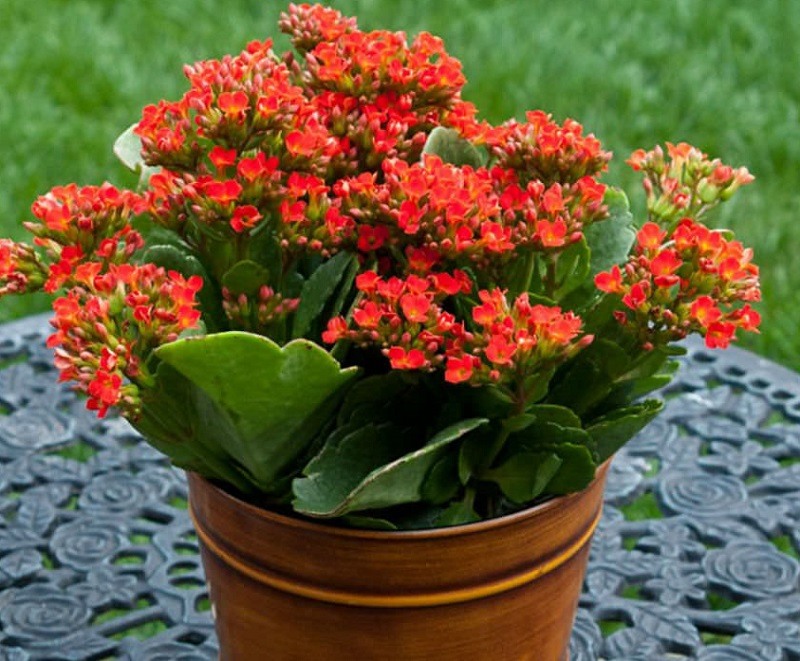Kalanchoe is a beautiful ornamental flowering plant that comes in a wide range of attractive bright red, pink, yellow, orange, and lilac bouquets. The striking clusters of tiny flowers grow all over the plant throughout the year.
So, why is my kalanchoe plant not flowering? The possible causes are natural dormancy, old blooms, watering issues, bright light conditions, extreme temperatures, incorrect soil drainage, and nutritional deficiency.
Growing and caring for the kalanchoe plant is an intimidating experience. It requires an individual with expertise to make the plant bloom. The information in this article highlights the reasons behind the kalanchoe plant not flowering.
You May Also Like: How to Care for Philodendron Birkin

Reasons for Kalanchoe Not Flowering
Improper Sunlight Exposure
Light is a vital component for the plant since it facilitates food synthesis. Kalanchoe plants need ample light to bloom. Kalanchoe plants bloom between late winter and late spring.
Low lighting condition triggers dormancy and leggy growth. Besides that, the plant will experience buds growth and discourage flower development.
Move the kalanchoe plant not flowering near the window that receives bright indirect sunlight. It will help stimulate the plant to bloom.
Another excellent option is to use artificial lightings in dark rooms. It is the best alternative to natural sunlight since it serves the same purpose.
Under-watering Problem
Kalanchoe plant is a low-maintenance houseplant that can tolerate drought conditions. The houseplant can wilt and fail to flower if it sits in dry potting soil for an extended period.
I recommend soaking the soil to revive the kalanchoe plant and encourage future flower production. Always inspect the soil moisture content before watering the plant.
Insert the index finger in 2-3 inches of the topsoil. Use distilled water or rainwater to irrigate your favorite houseplant. Develop a strict watering schedule to avoid the under-watering issue.
Incorrect Soil Drainage
Kalanchoe plants do best in light and well-draining potting soil. The soil texture encourages roots aeration and helps to prevent waterlog issues.
Overwatering problem is due to poor soil drainage. Kalanchoe plant hates sitting in a damp environment since it can result in root rot that discourages flowering.
Add compost to the well-draining soil to improve its fertility. The roots aeration, moisture, and compost will encourage your kalanchoe plant to flower.
Nutritional Deficiency
Kalanchoe plants need fertilizer nutrients during the blooming season. Flowers make the plant consume more energy and nutrients.
Underfeeding the kalanchoe plant will make the houseplant leggy and trigger flowers development. It also increases the risk of keeping unhealthy and unhappy houseplants.
I recommend feeding the kalanchoe every month during spring and summer. The nutrients will guarantee excellent blooming for years.
Extreme Temperatures
Indoor kalanchoe plants prefer a temperature range of 60-85oF. The temperature range will allow the plant to stay alive and even foster blooming.
Freezing temperatures trigger dormancy and discourage flowering. Besides that, too high temperatures will make your kalanchoe wilt and die.
Replicate the native habitat temperature range at home to encourage flowering and healthy growth. Keep the houseplant away from cold and hot drafts.
Natural Dormancy
Kalanchoe plants tend to flower between late winter and late spring. It begins to lose flowers at some point since the plant needs to rest and rebloom.
The houseplant will not flower between late summer and early fall. It is the period where the kalanchoe plant develops new buds in preparation for the next flowering period.
Put the plant near a south or west-facing window to give it adequate light in the spring. Natural light helps to trigger the kalanchoe plant to start producing flowers.
Lack of Pruning
Kalanchoe plants require optimum pruning requirements to enhance new bud development and blooming. Kalanchoe dead flowers deplete the energy and discourage new flowers formation.
Pruning kalanchoe help to remove the spent blooms. It redirects energy to the growing parts and triggers new flower formation in the long run.
You May Also Read: How to Care for Oxalis Triangularis
Related Questions
Why Are My Kalanchoe Flowers Dying?
Low lighting conditions are the reason behind kalanchoe flowers dying. Besides that, direct sunlight exposure for an extended period will burn or scorch the tiny flowers to death.
What to Do with Leggy Kalanchoe Plant?
Lack of sunlight will result in leggy kalanchoe plant. A low pruning routine is another possible cause of the leggy kalanchoe plant.
How Long Does It Take for Kalanchoe to Bloom?
It takes about six weeks after 14 hours of darkness to trigger flowering. Be sure to reduce watering and feeding during the resting period.
How often do Kalanchoe Plants Flower?
Kalanchoe plant tends to flower during late winter and late spring every year. These are the two kalanchoes flowering season.
You May Also Enjoy: How to Care for Calathea Warscewiczii
Final Thoughts
Kalanchoes are flowering succulents with numerous blooms varieties such as yellow, pink, bright red, orange, and lilac. It is a perennial and evergreen succulent with an average blooming of 45 to 65 days.
Kalanchoe plants are suitable for dry landscapes, container gardens, and indoor spaces. Getting kalanchoes to bloom after the first blooming season can be challenging. It usually depends on the current environmental conditions.
I hope the information in this article will help you know why kalanchoes are not flowering. Feel free to share the information with other houseplant enthusiasts in your community.
